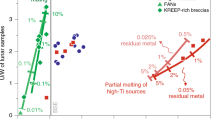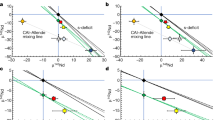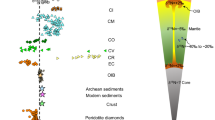Abstract
The Moon, Earth and eucritic meteorites display W/La ratios which correspond to depletions of W relative to chondrites by factors of ∼19 (ref. 1). This depletion can be attributed to metal/silicate fractionation. Ordinary chondrites and Cl chondrites with widely varying metal contents and oxidation states have similar W/La ratios, suggesting that nebular fractionations were unimportant. Therefore, assuming that both W and La are refractory and incompatible, the depletions of W relative to La in the Earth, Moon and eucrites are presumably due to separation of metal from silicate during planetary-scale igneous events. For the Moon, Rammensee and Wänke2 concluded that any geophysically reasonable metallic lunar core would be too small to explain the large lunar depletion of W. It was therefore suggested2 that the Moon acquired its depletion of W in a non-lunar igneous event, supporting the hypothesis that the Moon formed by fission from the proto-Earth, the upper portion of which was depleted in W due to terrestrial core formation3–5. We show here that this conclusion is implicity based on a special case, namely equilibrium between metal and silicate phases with total melting of silicates. In the geologically more general case where metal fractionates from silicate at relatively low degrees of partial melting, the incompatible nature of W may negate this conclusion. A geophysically plausible metallic core can account for the depletion of W in lunar surface and, presumably, lunar mantle rocks. The low W/La ratio in the Moon cannot be used as unconditional evidence for a terrestrial origin of the Moon.
This is a preview of subscription content, access via your institution
Access options
Subscribe to this journal
Receive 51 print issues and online access
$199.00 per year
only $3.90 per issue
Buy this article
- Purchase on Springer Link
- Instant access to full article PDF
Prices may be subject to local taxes which are calculated during checkout
Similar content being viewed by others
References
Wänke, H. et al. Proc. 4th lunar Sci. Conf. 1461–1481 (1973).
Rammensee, W. & Wänke, H. Proc. 8th lunar Sci. Conf. 399–409 (1977).
Ringwood, A. E. Origin of the Earth and Moon (Springer, Berlin, (1979).
Delano, J. W. & Ringwood, A. E. Proc. 9th lunar planet. Sci. Conf. 111–159 (1978).
Wänke, H., Dreibus, G. & Palme, H. Proc. 9th lunar Sci. Conf. 83–110 (1978).
Dreibus, G., Kruse, H., Spettel, B. & Wänke, H. Proc. 8th lunar Sci. Conf. 211–227 (1977).
Hood, L. L., Sonett, C. P., Herbert, F., Cantrell, S. & Smith, L. Lunar planet. Sci. 12, 457–459 (1981).
Russell, C. T., Coleman Jr, P. J. & Goldstein, B. E. Lunar planet. Sci. 12, 914 (1981).
Stevenson, D. J. & Yoder, C. F. Lunar planet. Sci. 12, 1043–1045 (1981).
Jones, J. & Drake, M. J. Lunar planet. Sci. 13, 369–370 (1982).
Stevenson, D. J. Science 214, 611–619 (1981).
Stocker, R. L. & Gordon, R. B. J. geophys. Res. 80, 4828–4836 (1975).
Walker, D., Stolper, E. M. & Hays, J. F. J. geophys. Res. 83, 6005–6013 (1978).
Anders, E. Space Sci. Rev. 3, 583–714 (1964).
Warren, P. H. & Wasson, J. T. Proc. 10th lunar Sci. Conf. 2051–2083 (1979).
Newsom, H. E. & Drake, M. J. Geochim. cosmochim. Acta (submitted).
Rambaldi, E. R., Wänke, H. & Larimer, J. W. Proc. 10th lunar planet. Sci. Conf. 997–1010 (1979).
Palme, H. et al. Proc. 9th lunar planet. Sci. Conf. 25–57 (1978).
Mason, B. U.S. geol. Surv. Prof. Pap. 440-B-l (1979).
Palme, H., Suess, H. E. & Zeh, H. D. in Landolt-Börnstein Group 6, Vol. 2, Part a 252–257 (Springer, Berlin, 1981).
Consolmagno, G. J. & Drake, M. J. Geochim. cosmochim. Acta 41, 1271–1282 (1977).
Palme, H. & Rammensee, W. Proc. 12th lunar planet. Sci. Conf. 949–964 (1981).
Myers, J. EOS 62, 1070 (1981).
Author information
Authors and Affiliations
Rights and permissions
About this article
Cite this article
Newsom, H., Drake, M. Constraints on the Moon's origin from the partitioning behaviour of tungsten. Nature 297, 210–212 (1982). https://doi.org/10.1038/297210a0
Received:
Accepted:
Issue Date:
DOI: https://doi.org/10.1038/297210a0
This article is cited by
-
Lunar magnetism (reply)
Nature (1984)
Comments
By submitting a comment you agree to abide by our Terms and Community Guidelines. If you find something abusive or that does not comply with our terms or guidelines please flag it as inappropriate.



